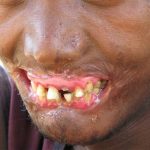 A rapidly progressive, polymicrobial, opportunistic infection occurring in immunocompromised or nutritionally deficient patients. Fusospirochetal organisms have been implicated.
A rapidly progressive, polymicrobial, opportunistic infection occurring in immunocompromised or nutritionally deficient patients. Fusospirochetal organisms have been implicated.
Acute ulceration of mucous membranes of the mouth or genitals, most often seen in undernourished children; it often leads to destruction of underlying bone and connective tissue.
A gangrenous disorder of the mouth (cancrum oris) or the genitals. Cancrum oris usually starts as an ulcer of the gum, which later causes death (necrosis) of the surrounding facial tissues, sometimes causing destruction of the lips or cheek. It is usually found in debilitated adults or undernourished children. The condition usually responds to antibiotics.
Noma, also known as cancrum oris, refers to the decay of tissue in the lips and cheeks caused by a bacterial infection. This affliction predominantly affects young children who are severely malnourished, residing in developing nations. Additionally, noma can manifest during the advanced phases of leukemia, a type of blood cancer.
The initial indication is the swelling of the gums and the inner lining of the cheeks. If left untreated, this progresses to significant ulceration (accompanied by an unpleasant odor), eventual deterioration of the jawbones near the mouth, and tooth loss. Healing takes place spontaneously over a period, yet the resulting scarring can be extensive.
Antibiotic medications and enhanced dietary intake interrupt the advancement of the illness. Plastic surgery might be employed for the restoration of impaired bones or the enhancement of facial aesthetics.
An exceptionally uncommon and severe inflammatory condition characterized by gangrene, which initiates in the mouths of severely weakened children and is frequently triggered by infectious diseases like measles. It can also affect the vulva and is alternatively referred to as cancrum oris or gangrenous stomatitis.
